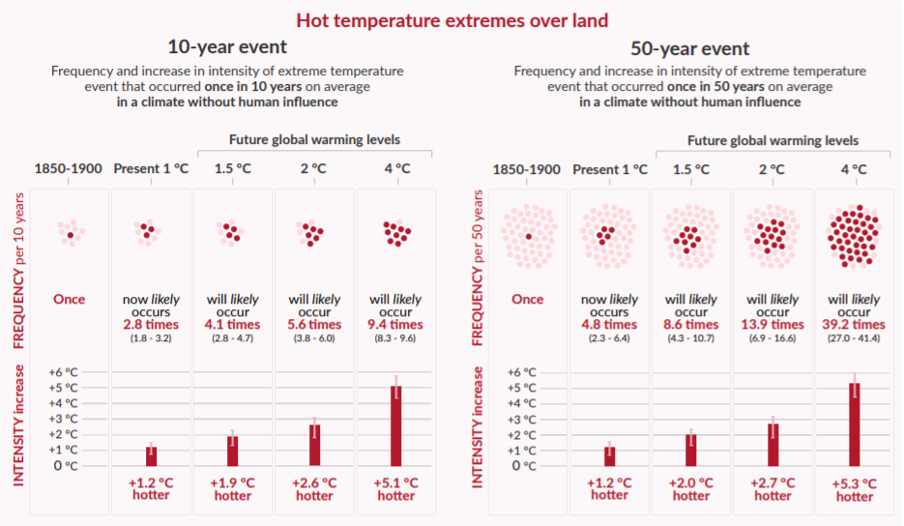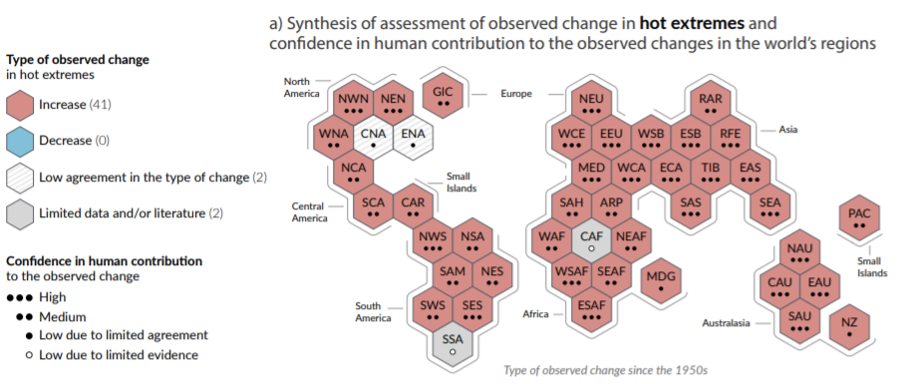Insights for business from the new IPCC report
Rasmus Valanko, Molly Walton, Luke Pritchard, Pallavi Ahuja, Kristen King and Sasha Chebil
Written by Rasmus Valanko, , with contributions from staff: Molly Walton, Luke Pritchard, Pallavi Ahuja, Kristen King, and Sasha Chebil,
Since its publication on Aug. 9, the IPCC’s Working Group I (WGI) report has received very similar commentary from all quarters — but there’s still much to be said about how companies can best learn from and apply these insights.
This is the first report of a series that together make up the Sixth Assessment report and it focuses on the physical science of climate change. The headlines will not be new to most people— climate change is happening, it’s caused by humans and it’s serious.
The report holds a daunting truth — now told with a much greater degree of accuracy around projections for global warming and its associated impacts. We are likely to reach an average surface temperature increase of 1.5°C around 2035. In a best-case scenario, we will slightly overshoot that mark – hitting 1.6°C – before cooling off again. This rise in temperature will come with increased frequency and severity of extreme weather events, causing devastating impacts to people and ecosystems as well as business continuity. We are already seeing an increase in the intensity of weather events today, with low-income communities and the least developed nations being disproportionately impacted.
 Excerpt from Figure SPM.6: Projected changes in the intensity and frequency of hot temperature extremes over land, extreme precipitation over land, and agricultural and ecological droughts in drying regions.
Excerpt from Figure SPM.6: Projected changes in the intensity and frequency of hot temperature extremes over land, extreme precipitation over land, and agricultural and ecological droughts in drying regions.
These extreme weather events pose a worldwide business and economic risk and a stark reality for companies in every industry and region of the world. They have already proven their ability to disrupt supply chains, impact business infrastructure, and negatively impact economic activity and public safety. Regardless of how quickly we move to limit our emissions, the IPCC makes crystal clear that extreme weather events will continue to become more commonplace and disruptive. Businesses will be left with no choice but to adapt and build resilience. But there are steps business leaders can take:
- While business efforts to date have focused on mitigation – and rightly so – corporate adaptation and resilience strategies will become increasingly commonplace and increasingly vital. Current business models are facing an unprecedented climate stress-test and companies that respond with robust adaptation strategies will score a competitive advantage. However, few companies have taken a structured approach to assessing the physical risk climate change has on their operations. Those that have done so, have limited their approach to owned or operated assets, with much less consideration for the full supply chain and indirect risks. The World Business Council for Sustainable Development’s report “Building Resilience in Global Supply Chains” is a good starting point to understand how to manage and adapt to supply chain risks.
- A company’s adaptation and resilience strategy must go beyond business operations and consider the broader impacts on society. This is not only about altruism, it’s also a case of business survival. For example, if a company is up and running quickly after an extreme weather event but none of their customers are, there will be little opportunity to recover revenues. While brand considerations are important, ultimately business cannot succeed in a society that fails.
The IPCC’s latest research poses another sobering fact. Unless we act now, the remaining carbon budget allotted to keep temperatures under a 1.5°C increase could be used up by 2027. It’s imperative that everyone go “all in” to mitigate climate change. It’s on business and government to accelerate the pace of action. For business this means two things:
- There will be an accelerated pace of new and more stringent regulation on greenhouse gas emissions across jurisdictions. This will come in the form of both penalties and incentives, so reduce your exposure to climate change regulation and position your business and innovation pipeline to benefit from incentives.
- Set a 1.5°C compatible target with ambitious interim milestones. There is no time to delay. Businesses need to be all in for halving emissions by 2030. By joining initiatives like Business Ambition for 1.5 Degrees, The Climate Pledge or SME Climate Hub, businesses can access the guidance and partners needed to help them on this journey.
The report also calls attention to the role that nature plays in our arsenal to limit global warming. Land and oceans act as a sink for more than half of emissions today. That is a huge leg up in our fight against climate change and should not be reduced but instead grown.
 Figure SPM.7: Cumulative anthropogenic CO2 emissions taken up by land and ocean sinks by 2100 under the five illustrative scenarios.
Figure SPM.7: Cumulative anthropogenic CO2 emissions taken up by land and ocean sinks by 2100 under the five illustrative scenarios.
- Once businesses have set an ambitious target and put in place robust plans to mitigate all that is technically and economically possible across supply chains, they must also invest in nature. The IPCC report now highlights – better than ever before – that we cannot limit global warming to 1.5°C unless we tackle the emissions from nature and increase its capacity to draw CO2 out of the atmosphere.
- Join one of the many initiatives helping corporates invest in high-quality projects to reduce emissions using nature-based solutions and encourage others to do so too. Examples include Natural Climate Solutions Alliance, the LEAF Coalition, the Business Alliance for Scaling Climate Solutions or 1t.org.
An associated insight from the report is the significant role that methane emissions have on global warming. The IPCC shows that methane has added roughly half a degree to the warming observed today. Methane emissions are a much more potent greenhouse gas than CO2 in the short-term, and action in the run up to 2030 must include a focus on methane. This links closely to nature, as most methane emissions are from agriculture.
- If a business’ value chain relies on agriculture, it will also be expected to address methane emissions by regulators, customers or the public. Expect new pressure and a growing search for solutions to reducing the impact of food and agriculture. The agricultural sector has seen minimal innovation compared to energy and transport, making it ripe for disruption in this critical decade ahead.
The last insight from the IPCC report focuses on the opportunities presented by the improved and more granular data now available.
- This report has, for the first time, made regional level information available and in an easily understandable format to allow companies to better perform a risk assessment. Businesses should task a dedicated team at their respective companies to review their risk matrices at the group, business line and asset level. Put mitigation plans in place and don’t forget to look at the opportunities that may open up as well.
 Excerpt of Figure SPM.3: Synthesis of assessed observed and attributable regional changes.
Excerpt of Figure SPM.3: Synthesis of assessed observed and attributable regional changes.
The IPCC’s climate science has once again served as a stark warning of things to come. Company staff, customers, voters and citizens around the world are increasingly alarmed. It is our job to give hope. Businesses can take action and lead the global Race to Zero by developing and deploying the solutions that we need and helping to build resilience among communities. Collaboration will be the only way to make this happen at the pace and scale required — and businesses remain at the heart of the action.

